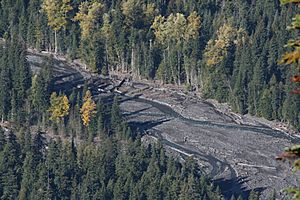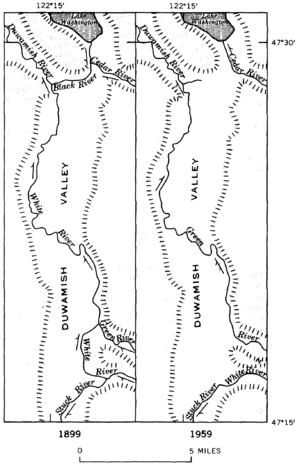White River (Washington) facts for kids
Quick facts for kids White River |
|
|---|---|
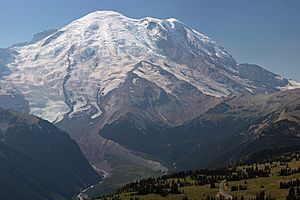
Emmons Glacier (left) on the northeast side of Mount Rainier, the source of the White River (lower left)
|
|
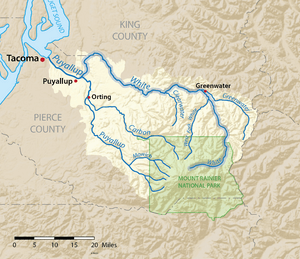
The White River is shown highlighted in the Puyallup River watershed
|
|
| Other name(s) | Stuck River |
| Country | United States |
| State | Washington |
| Counties | Pierce, King |
| City | Buckley |
| Physical characteristics | |
| Main source | Mount Rainier Emmons Glacier 5,050 ft (1,540 m) 46°53′7″N 121°40′24″W / 46.88528°N 121.67333°W |
| River mouth | Puyallup River 29 ft (8.8 m) 47°11′59″N 122°15′31″W / 47.19972°N 122.25861°W |
| Length | 75 mi (121 km) |
| Basin features | |
| Basin size | 494 sq mi (1,280 km2) |
| Tributaries |
|
The White River is a cool, icy river in Washington state, USA. It gets its name because its water often looks white from all the tiny rock particles carried from glaciers. This river flows about 75 miles (121 km) from its starting point, the Emmons Glacier on Mount Rainier. It eventually joins the Puyallup River near Sumner. The White River also forms part of the border between King and Pierce counties.
There is another White River in Washington that flows into Lake Wenatchee.
Contents
The River's Journey
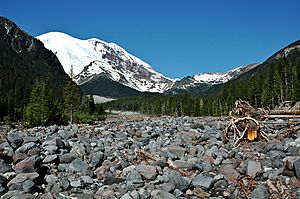
The White River begins at the Emmons Glacier on the northeast side of Mount Rainier. It flows out of ice caves at the bottom of the glacier. The first part of the river is inside Mount Rainier National Park.
After leaving the glacier, the White River flows east past the White River Campground and Ranger Station. Then it turns north. A road called State Route 410 follows the river for much of its upper path. After a few miles, the river leaves the national park and enters the Mount Baker-Snoqualmie National Forest.
The river slowly turns west, passing several forest campgrounds. Huckleberry Creek joins it there. A few miles downstream, the White River is joined by the West Fork White River. This fork also starts from a glacier in Mount Rainier National Park, called Winthrop Glacier. Even further down, another big river, the Greenwater River, joins the White River near the small town of Greenwater.
Flowing Westward
Below Greenwater, the White River generally flows west. It goes past Federation Forest State Park. Then, the Clearwater River adds its waters. Several miles later, the White River is held back by Mud Mountain Dam. This dam creates a marshy lake called Mud Mountain Lake, which only fills during very high water. The dam helps control floods.
After Mud Mountain Dam, the White River enters the area near Tacoma. It flows between the cities of Buckley and Enumclaw. Then it makes a big curve, flowing around Lake Tapps. North of the lake, the White River goes through the Muckleshoot Indian Reservation. West of Lake Tapps, the river enters a wide, flat area called a floodplain. It flows past the city of Pacific before joining the Puyallup River at Sumner.
Lake Tapps is a reservoir made in 1911 to produce electricity. A special dam near Buckley sends some of the White River's water through channels and pipes to Lake Tapps. Water then flows out of the lake through turbines at the Dieringer Powerhouse. This water then returns to the lower White River, which is sometimes called the "Stuck River" in this area.
How the River Changed
Before 1906, the White River used to join the Green River near Auburn. Together, they formed the Duwamish River, which flowed into Elliott Bay in Seattle.
In 1906, a huge flood and a large jam of logs and debris changed the White River's path. It started flowing south into the Stuck River, and then into the Puyallup River. This river flows into Commencement Bay at Tacoma. The debris jam was replaced with a permanent wall to keep the river flowing this new way. So, today the White River is a branch of the Puyallup River.
Controlling Floods
In the late 1800s, farmers along the White River often faced floods every year. Sometimes, they even used dynamite to try and move the river into different channels. In 1899, one such explosion accidentally sent most of the White River into the Stuck River. This continued until the big flood of 1906, which made the entire White River flow down the Stuck River.
Because of the flood risk, Pierce County did not want the White River to flow into their area. They sued King County to try and make the White River go back to its old path. The lawsuit lasted for years until 1913. The two counties finally agreed: Pierce County would keep the White River, but King County would pay 60% of the costs to control floods.
Dams, walls, and barriers were built along the White River to stop major floods. But in 1933, another large flood hit the area. The counties realized they couldn't control the river alone, so they asked the federal government for help. This led to the building of Mud Mountain Dam.
Mud Mountain Dam was finished in 1948 by the United States Army Corps of Engineers. It was built to control floods. The dam blocks fish from swimming upstream to lay eggs. So, a "trap and haul" system is used: fish are caught and then moved around the dam by truck. After the dam was built, farmers along the lower White River no longer had to worry about constant flooding.
Lake Tapps and Water Use
In 1911, a diversion dam was built near Buckley. This dam, along with walls around the small Lake Tapps, created a much larger lake. Over the years, a community grew around Lake Tapps. The water from the lake returns to the White River about 20 miles (32 km) downstream from the diversion dam.
The lake was once owned by Puget Sound Energy. Now, it is owned by Cascade Water Alliance (CWA). CWA is studying how to use the lake as a source of drinking water. The lake has also been part of plans to improve water quality in the White River area.
River Life: Fish and Wildlife
The White River and its smaller streams are home to many types of salmon. These include chinook, pink, chum, and coho salmon. Other fish like bull trout, rainbow trout, steelhead, and coastal cutthroat trout also live here. Pink and chum salmon are the most common types. Even though there are no big natural lakes in the area, a few sockeye salmon can also be found.
Some types of fish in the White River, like the Puget Sound chinook salmon, steelhead, and bull trout, are listed as "threatened." This means their numbers are low, and they need protection to survive.
River History
The White River valley was a place of conflicts between Native Americans and the local militias and the U.S. Army. This happened during the Puget Sound War of 1855-1856. During this time, volunteer U.S. troops were surprised while working on a project near a ferry crossing the river.
|


